Key takeaways:
- A sturdy armature is crucial for providing support in sculptures, preventing them from collapsing.
- Planning and selecting appropriate materials are essential for a successful armature build.
- Regularly checking for balance and reinforcing connections can prevent structural failures.
- Adding details and final touches significantly enhances the visual impact and stability of the piece.
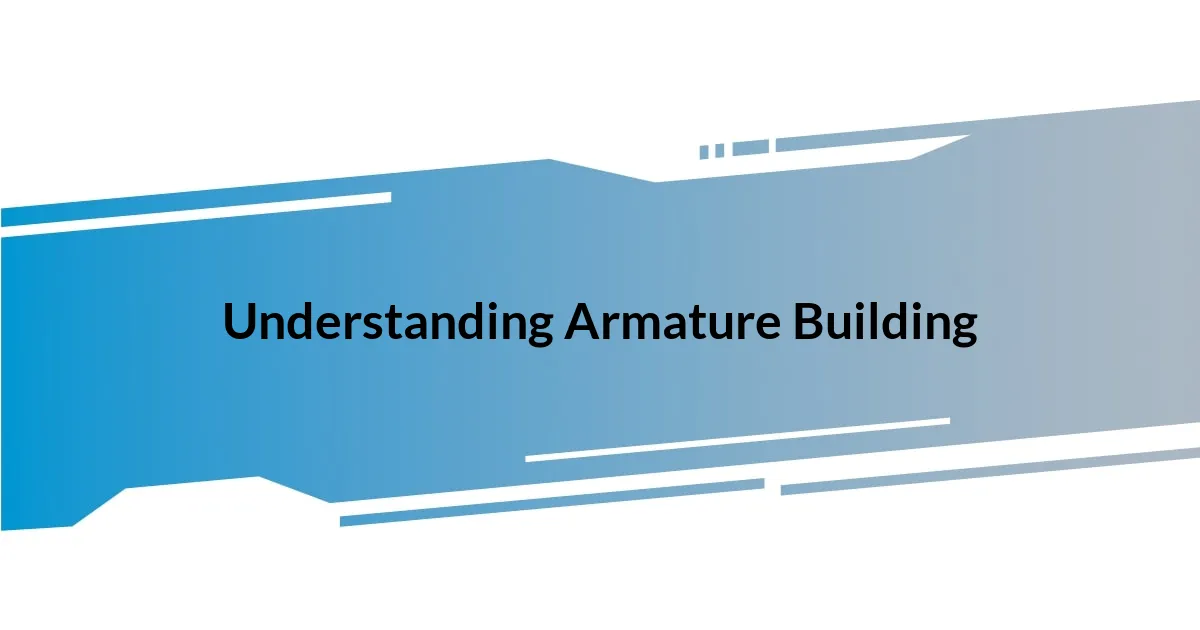
Understanding Armature Building
Armature building is a fascinating process that creates the underlying support for sculptures, especially when working with soft materials like clay or plaster. I remember when I first began, I was surprised at how crucial a sturdy armature was; it felt like the backbone of my work, holding everything together. Have you ever tried to shape something only to watch it crumble? That can be a common experience without proper support.
Using materials like wire or wood for the framework has its own challenges and rewards. I once attempted to craft a complex figure out of thin wire, and I learned the hard way that too little structure leads to frustration. It made me appreciate how every artist develops their unique approach to armature building—it’s a journey of trial and error, wouldn’t you agree?
What truly excites me is how diverse the applications of armature building can be, from tiny miniature figures to life-sized installations. I often find myself pondering how different techniques can enhance the final outcome. Each decision, from the material choice to its shape, can completely transform the piece, making it a deeply personal experience. How do you envision your ideas taking shape?
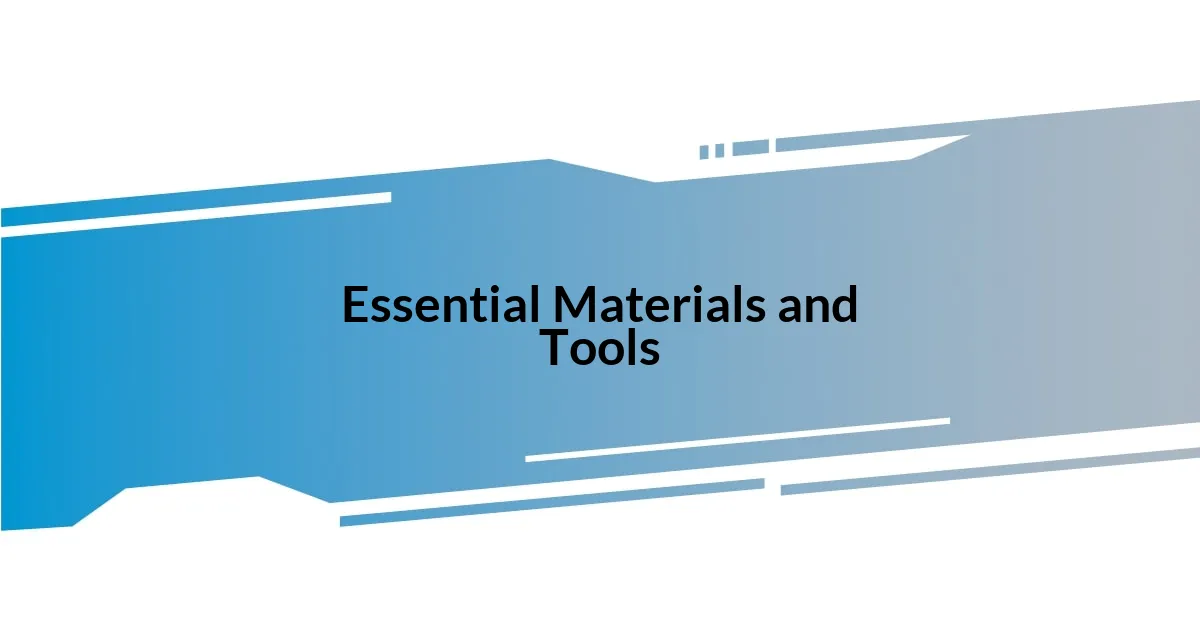
Essential Materials and Tools
When it comes to essential materials for armature building, I find that wire, wood, and metal rods consistently rise to the top of my list. I remember the first time I used aluminum wire; it was incredibly flexible and easy to manipulate, making it a favorite for intricate designs. However, I’ve also ventured into the realms of wooden dowels, which can offer sturdiness for larger sculptures. The balance between flexibility and strength is key in crafting a reliable armature.
As for tools, having the right ones is a game-changer. A good pair of wire cutters and pliers become your best friends. I’ll never forget the moment I tried to shape a heavy figure but lacked the proper tools. It was frustrating, and I ended up with sore fingers and a lot of wasted material. Investing in quality tools transforms the building experience—suddenly, it feels more like creating rather than struggling.
Here’s a handy comparison of materials and tools I recommend:
| Material/Tool | Characteristics |
|---|---|
| Aluminum Wire | Lightweight and flexible, great for detailed armatures |
| Wooden Dowels | Sturdy and stable, suitable for larger sculptures |
| Metal Rods | Durable and strong, excellent for heavy structures |
| Wire Cutters | Essential for cutting wire easily |
| Pliers | Helpful for bending and shaping wires |
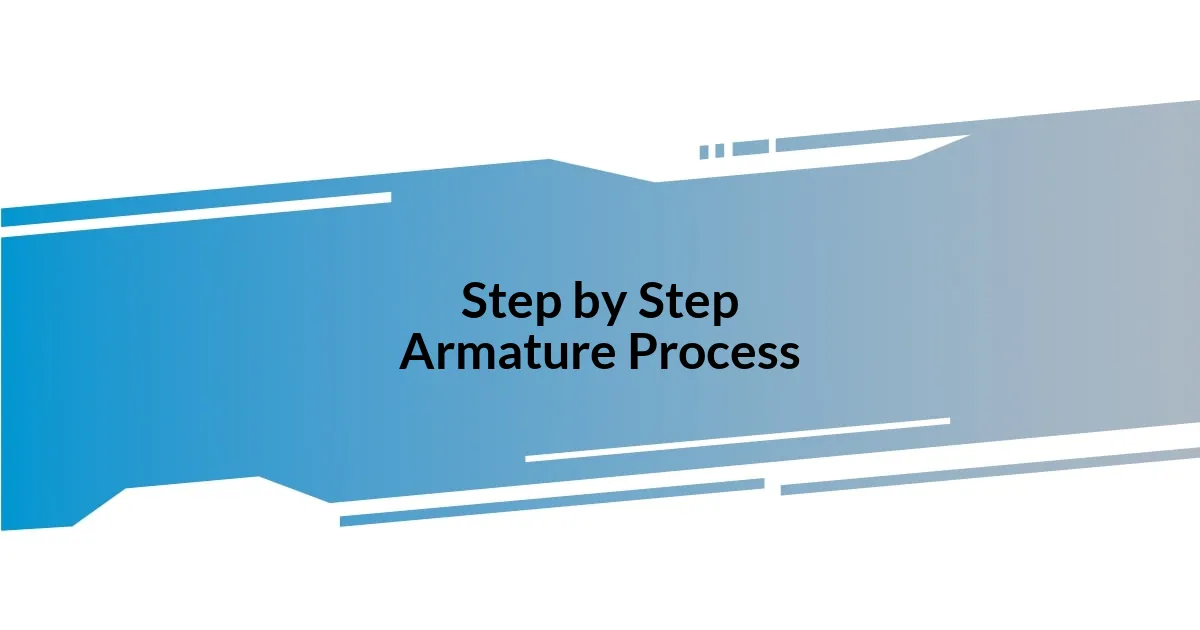
Step by Step Armature Process
Building an armature is a process I’ve come to embrace over time, and I believe it’s essential to follow a structured approach. When I first started, I often jumped in without a clear plan, and I quickly realized that having a step-by-step method not only saves time but also enhances the quality of the final piece. For me, the process can be boiled down to the following steps:
- Design Your Sculpture: Sketch your idea. Visualization helps in figuring out the armature’s shape and size.
- Choose Materials: Decide whether you want to use wire, wood, or metal based on the scale and detail of your work.
- Create the Frame: Start assembling the primary structure, ensuring that it’s stable enough for the material you’ll be applying.
- Add Support: Reinforce areas that will require extra stability, like joints and heavy sections.
- Test for Balance: Check the armature’s balance. I once neglected this step and ended up with a sculpture that toppled over, which was quite the learning moment for me.
I find that patience during this phase pays off in the long run. Rushing through can lead to unforeseen issues.
As I engaged in making armatures, I’ve learned that fine-tuning each step is crucial. I recall a particularly memorable project where I was working on a large figure. I started off with a flimsy base, thinking it would suffice, only to discover that I had to dismantle and rebuild halfway through. The experience taught me the importance of careful planning and execution. Here’s a straightforward outline to keep in mind as you embark on your armature-building adventures:
- Materials Selection: Think about the best materials for your project’s needs—flexibility vs. durability.
- Initial Framework: Construct a basic shape that captures the essence of your design.
- Detailing: Incorporate finer elements as needed, ensuring they are well supported.
- Final Adjustments: Step back and evaluate your armature for any necessary tweaks before adding your final materials.
Every project has its lessons, and I believe every artist develops their own rhythm in this process. What’s your go-to approach?
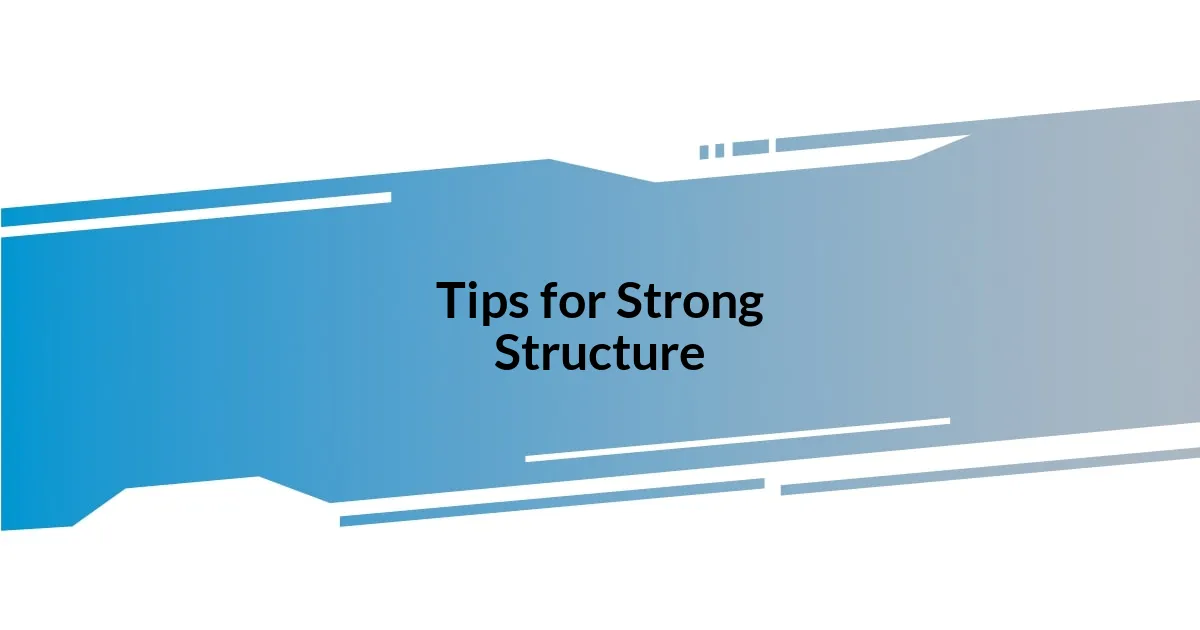
Tips for Strong Structure
Achieving a strong structure in armature building often starts with the foundation. I learned the hard way that a sturdy base is non-negotiable. During one project, I rushed through the initial setup, thinking I’d just fix any wobbling later. But as I added weight, my sculpture began to lean precariously. It was a wake-up call! Now, I always ensure my base is solid before anything else, as it truly sets the stage for the rest of the piece.
Another critical tip I’ve picked up is to double-check your connections. I remember a time when I thought I’d secured everything, only to discover a joint came apart right as I was about to apply the final layer. That moment of panic is something I’d like to spare any of you! Reinforcing joints with additional material or using a stronger adhesive can save you from those heart-stopping moments when a beloved creation is on the verge of crumbling.
Lastly, never underestimate the power of balance. I once worked on a piece that looked stunning from every angle—except one. I realized too late that my armature wasn’t evenly weighted, resulting in a precarious situation. Make it a habit to step back regularly and check how your armature stands from various perspectives. Is it stable? Does it capture your design’s essence? Trust me, a little foresight can go a long way in ensuring your hard work pays off.

Common Mistakes to Avoid
It’s incredibly easy to overlook the importance of planning when building an armature. I remember diving into a project without sketching a clear plan. The result? A chaotic mess that barely resembled my initial vision. I grew frustrated with the wasted time and effort. Now, I emphasize that taking the time to draft a design isn’t just helpful—it’s essential. So, why rush through the creative process?
One mistake I often see is choosing the wrong materials. Early in my journey, I used lightweight wire for a larger sculpture, thinking it would give me flexibility. What happened? My armature couldn’t support the weight of the clay, and I had to start all over again! It’s a heart-sinking feeling watching your hopes and dreams collapse because you didn’t consider material suitability. Choose wisely, as that choice can make or break your entire piece.
Lastly, neglecting that balance check can lead to disaster. I vividly recall setting up an intricately designed figure only to grasp later that it leaned dramatically to one side. The moment of realization was gut-wrenching! Balancing my armature became a non-negotiable step, and I began making it a point to examine my work from every angle. What about you? Have you ever felt that sinking feeling when a piece doesn’t stand as it should? It’s a reminder that a solid armature is the foundation for success.

Enhancing Armature with Details
When it comes to enhancing your armature with details, I’ve found that the smallest touches can make a big impact. I vividly remember adding subtle details to the joints of one of my earlier sculptures. I used an unexpected material—tiny bits of fabric—to wrap around the wire. It not only helped reinforce the connection but also added texture, elevating the overall aesthetic. What surprised me most was how much it transformed the piece, giving it a more polished and professional look.
Adding realistic features is another avenue I love exploring. One time, I experimented by sculpting tiny musculature onto my armature, which not only mirrored the movement I envisioned but also created a sense of life within the structure. Witnessing the form start to embody its character was exhilarating! Have you ever tried incorporating anatomical details into your armature? It’s like breathing life into a skeleton; suddenly, your piece feels more vibrant and expressive.
Lastly, don’t shy away from using colors and finishes to enhance your armature. Early on, I painted parts of my armature to visually connect them to the finished piece. At first, I was unsure if it would detract from the eventual layers I’d apply, but instead, it became an integral part of the overall design. My advice? Play with textures and hues! It can really pull viewers in and add depth. After all, isn’t art about evoking emotion? So let your armature whisper stories long before it’s fully realized.
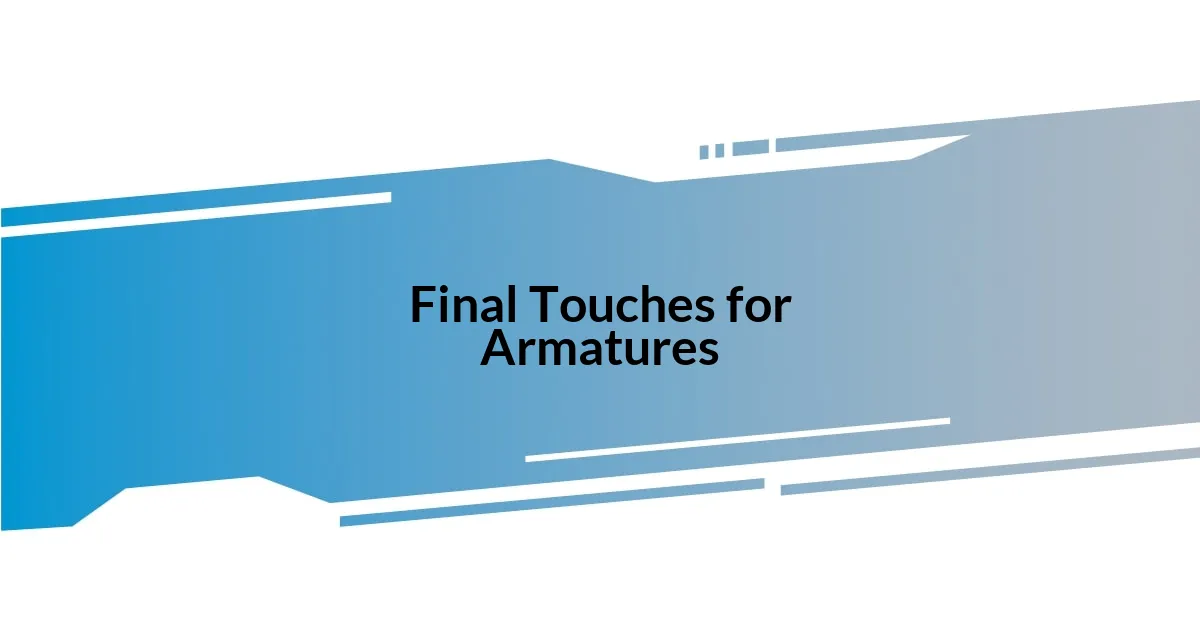
Final Touches for Armatures
Final touches on your armature can be the difference between a solid foundation and a wobbly disaster. I recall a project where, after all my effort, I decided to reinforce the support structure with a few extra layers of tape. It seemed minor, but that added security gave me peace of mind. I felt like I was finally in control, steering the piece towards its final form.
Don’t underestimate the power of adjusting proportions during these final moments. I remember standing back and realizing one arm was slightly longer than the other. A quick tweak made all the difference! Have you ever had that moment when a simple adjustment turned an “okay” piece into something truly balanced? It’s those little victories that keep me motivated.
Lastly, I recommend stepping back to evaluate your armature as a whole before you move on. When I learned this lesson, I was blown away by how a fresh perspective could reveal hidden imbalances or awkward angles. It’s like looking at a painting—you might not notice inconsistencies up close, but from a distance, the flaws become glaring. So, take that step back and truly see your work; it can save you from costly mistakes later.